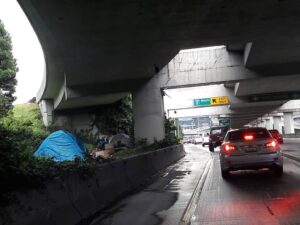The Cleanup of Biohazards & Other Health Threats Posed by Homeless Encampments
Cleanup due to homelessness is a hot topic right now. Cities cross the country are struggling with the issue of homelessness, and here in the Washington state area it’s no different. In fact, our largest city, Seattle, has one of the highest rates of homelessness in the country. (Seattle, with almost 12,000 counted as homeless in 2017) is third, after New York and Los Angeles.
 Many of those who are classified as homeless live in encampments scattered about in highly populated areas. ‘Tent cities’ often spring up under freeway overpasses and other public spaces like parks. Though there are sanctioned areas, most of these dwellings are illegal, and periodically the city is forced to close it down, clear it up, and clean it up.
Many of those who are classified as homeless live in encampments scattered about in highly populated areas. ‘Tent cities’ often spring up under freeway overpasses and other public spaces like parks. Though there are sanctioned areas, most of these dwellings are illegal, and periodically the city is forced to close it down, clear it up, and clean it up.
The Major Biohazards Associated with Homeless Encampments
Cleanup of a homeless encampment poses substantial risk of exposure to and spreading of biohazards as well as other health dangers. A report issued by the City of Tacoma (part of the Seattle metro area) identified these major threats:
- Blood-borne pathogens – most commonly hepatitis and HIV/AIDS, but also MRSA (antibiotic-resistant staph infection)
- Biohazards due to bodily waste (feces, vomit, etc.)
- Discarded drug paraphernalia (needles and syringes)
- Rodents (rats can carry the hanta virus, which can result in kidney failure due to febrile hemorrhagic disease)
- Drug production (meth labs, etc.)
The proliferation of trash that accumulates includes hazards associated with such things as rotting food, dirty diapers, venomous spiders like the black widow and yellow sac, and more.
But it’s not just these large urban homeless camps that require cleanup. Property owners and businesses often must deal with health threats due to small numbers of homeless individuals routinely ‘crashing’ on their property.
The most important thing we want to stress is that cleanup from a homeless dwelling should NOT be undertaken by untrained individuals. Special protective clothing and equipment is required. Whether a homeless dwelling area is a large under-freeway encampment or a couple of tents behind a store, cleanup should be done by professionals who are trained in and have the equipment to deal with the toxic matters that may be present. It is critical to be aware of potential hazards, because untrained individuals may not even recognize threats posed.
- Debris needs to be removed safely
- Debris needs to be disposed of safely
- The area needs to be decontaminated and restored
Our crews are trained in the abatement of biohazards and safe cleanup of homeless encampments. For assistance in the Seattle area, call us at (877) 684-9753. We are available 24/7. (For other areas, call this number and ask about our availability.)



